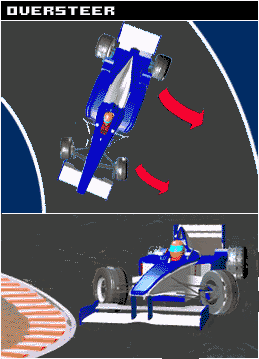Overesteer

Oversteering is the tendency of a car's rear to slip out in mid-corner, turning front of the car to much in the corner. That is, the car spins out too much. Oversteering is different thing and must not the be confused with "Drifting" or "Power Sliding".
Generally, drifting is induced by driver with wheels losing grip intentionally and should be controllable with the throttle and steering wheel. Whereas, understeering and oversteering is not intentionally induced and is mostly uncontrollable and unwanted.
Engineers aim is to get rid of understeer and oversteer as much as possible, since it ruins lap times and inducing tire wear. Although in real life, a slightly understeering car (very slightly) is always faster than an oversteering car. But again, some drivers have they own preferences. Sometimes wrong one!
Understeer an oversteer problems can be best fixed with fine tuning of suspension elements or changing the ballast position.
Oversteer and understeer are vital to understanding the way a car corners.
Understeer is inherently stable - once the car reduces speed sufficiently grip will be restored, which is why almost all road cars are set up to understeer at the limit of adhesion. But it also slows down a car, which is why Formula One chassis engineers try to avoid it. Oversteer is, by contrast, highly unstable. Unless a driver acts to correct it quickly with skilful use of steering and throttle it can result in a spin. But an 'oversteery' chassis helps the driver to turn into a corner and, at the limit of adhesion, it enables a skilled driver to carry far more speed through a corner than understeer. Which is why, to a greater or lesser extent, all Formula One cars are set up with an oversteer characteristic.






